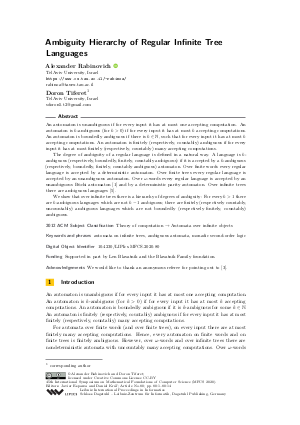Ambiguity Hierarchy of Regular Infinite Tree Languages
Authors
Alexander Rabinovich  ,
Doron Tiferet
,
Doron Tiferet
-
Part of:
Volume:
45th International Symposium on Mathematical Foundations of Computer Science (MFCS 2020)
Part of: Series: Leibniz International Proceedings in Informatics (LIPIcs)
Part of: Conference: Mathematical Foundations of Computer Science (MFCS) - License:
 Creative Commons Attribution 3.0 Unported license
Creative Commons Attribution 3.0 Unported license
- Publication Date: 2020-08-18
File

PDF
LIPIcs.MFCS.2020.80.pdf
- Filesize: 0.51 MB
- 14 pages
Document Identifiers
Subject Classification
ACM Subject Classification
- Theory of computation → Automata over infinite objects
Keywords
- automata on infinite trees
- ambiguous automata
- monadic second-order logic
Metrics
- Access Statistics
-
Total Accesses (updated on a weekly basis)
0Document
0Metadata
Abstract
An automaton is unambiguous if for every input it has at most one accepting computation. An automaton is k-ambiguous (for k > 0) if for every input it has at most k accepting computations. An automaton is boundedly ambiguous if there is k ∈ ℕ, such that for every input it has at most k accepting computations. An automaton is finitely (respectively, countably) ambiguous if for every input it has at most finitely (respectively, countably) many accepting computations. The degree of ambiguity of a regular language is defined in a natural way. A language is k-ambiguous (respectively, boundedly, finitely, countably ambiguous) if it is accepted by a k-ambiguous (respectively, boundedly, finitely, countably ambiguous) automaton. Over finite words every regular language is accepted by a deterministic automaton. Over finite trees every regular language is accepted by an unambiguous automaton. Over ω-words every regular language is accepted by an unambiguous Büchi automaton [Arnold, 1983] and by a deterministic parity automaton. Over infinite trees there are ambiguous languages [Carayol et al., 2010]. We show that over infinite trees there is a hierarchy of degrees of ambiguity: For every k > 1 there are k-ambiguous languages which are not k-1 ambiguous; there are finitely (respectively countably, uncountably) ambiguous languages which are not boundedly (respectively finitely, countably) ambiguous.
Cite As Get BibTex
Alexander Rabinovich and Doron Tiferet. Ambiguity Hierarchy of Regular Infinite Tree Languages. In 45th International Symposium on Mathematical Foundations of Computer Science (MFCS 2020). Leibniz International Proceedings in Informatics (LIPIcs), Volume 170, pp. 80:1-80:14, Schloss Dagstuhl – Leibniz-Zentrum für Informatik (2020)
https://doi.org/10.4230/LIPIcs.MFCS.2020.80
BibTex
@InProceedings{rabinovich_et_al:LIPIcs.MFCS.2020.80,
author = {Rabinovich, Alexander and Tiferet, Doron},
title = {{Ambiguity Hierarchy of Regular Infinite Tree Languages}},
booktitle = {45th International Symposium on Mathematical Foundations of Computer Science (MFCS 2020)},
pages = {80:1--80:14},
series = {Leibniz International Proceedings in Informatics (LIPIcs)},
ISBN = {978-3-95977-159-7},
ISSN = {1868-8969},
year = {2020},
volume = {170},
editor = {Esparza, Javier and Kr\'{a}l', Daniel},
publisher = {Schloss Dagstuhl -- Leibniz-Zentrum f{\"u}r Informatik},
address = {Dagstuhl, Germany},
URL = {https://drops.dagstuhl.de/entities/document/10.4230/LIPIcs.MFCS.2020.80},
URN = {urn:nbn:de:0030-drops-127495},
doi = {10.4230/LIPIcs.MFCS.2020.80},
annote = {Keywords: automata on infinite trees, ambiguous automata, monadic second-order logic}
}
Author Details
Funding
Supported in part by Len Blavatnik and the Blavatnik Family foundation.
Acknowledgements
We would like to thank an anonymous referee for pointing out to [Marcin Bilkowski and Michal Skrzypczak, 2013].
References
- André Arnold. Rational omega-languages are non-ambiguous. Theor. Comput. Sci., 26:221-223, September 1983. URL: https://doi.org/10.1016/0304-3975(83)90086-5.
-
Vince Bárány, Łukasz Kaiser, and Alex Rabinovich. Expressing cardinality quantifiers in monadic second-order logic over trees. Fundamenta Informaticae, 100(1-4):1-17, 2010.

- Marcin Bilkowski and Michal Skrzypczak. Unambiguity and uniformization problems on infinite trees. In Simona Ronchi Della Rocca, editor, Computer Science Logic 2013 (CSL 2013), CSL 2013, September 2-5, 2013, Torino, Italy, volume 23 of LIPIcs, pages 81-100. Schloss Dagstuhl - Leibniz-Zentrum für Informatik, 2013. URL: https://doi.org/10.4230/LIPIcs.CSL.2013.81.
-
Arnaud Carayol and Christof Löding. MSO on the infinite binary tree: Choice and order. In International Workshop on Computer Science Logic, pages 161-176. Springer, 2007.

-
Arnaud Carayol, Christof Löding, Damian Niwinski, and Igor Walukiewicz. Choice functions and well-orderings over the infinite binary tree. Open Mathematics, 8(4):662-682, 2010.

-
E Allen Emerson and Charanjit S Jutla. Tree automata, mu-calculus and determinacy. In FoCS, volume 91, pages 368-377. Citeseer, 1991.

-
Yuri Gurevich and Leo Harrington. Trees, automata, and games. In Proceedings of the fourteenth annual ACM symposium on Theory of computing, pages 60-65, 1982.

-
Yuri Gurevich and Saharon Shelah. Rabin’s uniformization problem 1. The Journal of Symbolic Logic, 48(4):1105-1119, 1983.

-
Damian Niwiński. On the cardinality of sets of infinite trees recognizable by finite automata. In Andrzej Tarlecki, editor, Mathematical Foundations of Computer Science 1991, pages 367-376, Berlin, Heidelberg, 1991. Springer Berlin Heidelberg.

- D. Perrin and J.É. Pin. Infinite Words: Automata, Semigroups, Logic and Games. ISSN. Elsevier Science, 2004. URL: https://books.google.fr/books?id=S7hHhJc4iNgC.
-
Michael O Rabin. Decidability of second-order theories and automata on infinite trees. Transactions of the american Mathematical Society, 141:1-35, 1969.

-
Wolfgang Thomas. Automata on infinite objects. In Formal Models and Semantics, pages 133-191. Elsevier, 1990.

-
Boris A. Trakhtenbrot and Ya. M. Barzdin. Finite automata, behavior and synthesis. 1973.

